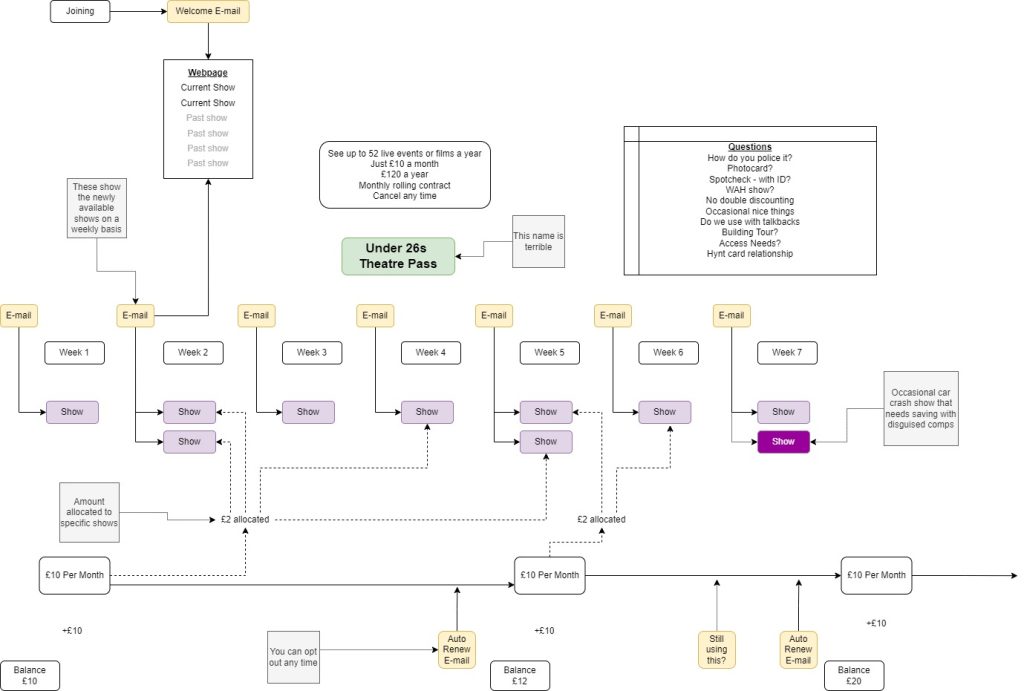I’ve not annoyed as many people as usual recently with my theatre blog posts – this one however will infuriate so many people because it’s a beginners guide and doesn’t mention a huge amount of complexity and data that underpins what I’m talking about. So, if you’re reading this and thinking “this is utter bullshit – I’m going to tweet him and point out his obvious errors” then please don’t.
Also they may not be errors… Fairly frequently in arts marketing the words fact and opinion gets mixed up (and they’re arguably different things), something that works in one context may not work in another. If you do disapprove of this post then let’s use a code, just tweet me saying “top bananas” and I’ll know that fundamentally you think I’ve a way with words but that there are bits of the content that you disagree with (or would change). And you should also leave a comment too – at the bottom – even if just to say hi.
Oh and I’ve tried to make this marginally light-hearted so it’s not-quite-as-dry-as-you-think-it’s-going-to-be, and also to make it almost entirely un-shareable in any serious forum. Also, if you’re not a beginner (Roger/Robin/Crayg/Kate/Stephen) then scroll to the bottom for an interesting thing.
That’d be the perfect mix – “top bananas” and comment below. Cheers, Sam x
How do you set the price of an orange?
Do you…
- Start selling it for £100 and then if no-one buys it then gradually reduce it until someone does?
- Check what price other people are selling their oranges for?
- Work out how much it costs to grow and sell the orange, then make that the price?
- Start cheap and then promise yourself you’ll charge more for your next orange?
What if people don’t know what an orange is?
What if they don’t know that it’s tasty, juicy and delicious?
What if they’ve no idea that the orange might be nominated for a WhatsOnFruit award?
What if you’re specifically funded to make sure that people from all backgrounds have access to oranges, even people who like apples? What if the orange has a limited shelf life? What if it is enriched with vitamin C? What if sometimes they leave people disappointed when they’re a bit sour?
Setting the price of anything should be easy, it instinctively sounds easy (it’s not), but for theatre tickets it always feels and sounds and is, much harder. How do you put those ticket holders in a space, watching a show that they may hate or love, in a way that feels smart, well-thought through, and, because we’re hippy, left-leaning liberals, fair.
I thought that rather than preach about what you should do with your pricing (always risky), instead I’d talk through my journey and understanding with pricing – the steps my head went through, some of the challenges, my thoughts and questions, and, eventually where I think the future might lie.
I’ve also put some ponderings at the end which, well, think of them as DVD extras – entirely unnecessary and don’t do anything to drive the narrative.
Sound okay? Then we’ll begin.
#1 – Free-for-all
This is everyone’s default starting point – a theatre ticket buys you a) entry and b) a seat, but nothing more complex than that. It’s the one that every now and then patrons will go all misty-eyed about… In my example I’ve a 50 seat studio theatre (originally named The Sam Freeman Memorial Theatre), all the seats are quite good and all the seats are fully accessible. Oh, and my studio theatre is funded, so I’ve a civic and cultural responsibility rather than it just being about cold, hard cash.

Pros
- It’s simple to understand and explain
- The auditorium will usually fill from the front and centre which is good for performers
- It feels fair
- You can book late and get the best seat
Cons
- It isn’t fair – one ticket price discriminates horrifically against low income groups (as a starter for ten).
- Your bar sales will be shit as to get the seat you want you have to start queuing 20 mins before the show starts.
- For busy shows you’ll have to ask people to budge up and fill in gaps, your ushers will be anxious about this, sometimes someone will stand in an aisle in protest, or mutter under their breath about this being “ridiculous”.
- It’s stressful if you have a family, are disabled, have anxiety issues or are a new customer (as a starter for ten)
- There’s very little motivation to book early – you can book late and get the best seat.
- Lots of pushing and “do you mind” and passive-aggressive audience behaviour when it’s even slightly busy. Some people will use coats in a Russian-style occupation of multiple seats that clearly don’t belong to them.
- I’d like to bet you have to put signs on seats saying “reserved” for show directors or VIPs which makes the entire audience stare at them passive aggressively.
Rating: 1/10
#2 – Free-for-all (with concessions)
So this is the first step up. It recognises that some people need a bit of support attending so we introduce concessions. They’re a tricky old beast to manage and work out – there isn’t really a right or wrong answer to them – it’s about enabling access by grouping people in a way that puts them economically in the same group. It’s slightly hopeless because while under 17s might get a concession to attend (most of them have very limited disposable income), for over 60s there’s a huge disparity in the range of people’s incomes and what they can afford. If you’re going to offer a concession make it count, but also recognise that identifying who does and doesn’t have disposable income is incredibly difficult. This version at least offers a little support where, in the previous version there was none.
Rating: 1.5/10

#3 – Let’s Go Reserved
So you’ve decided to go for reserved seating. You’ve had a long time wondering if it’s possible (“yes”), whether the directors and designers will deal with the horrific restrains this will bring (“yes, easily”) and how we’ll deal with people who loved the unreserved layout (“they’ll get over it remarkably quickly”). But this new found ability to reserve seats comes with new things to deal with. People have their “favourite” seats, can they have them? Also, it doesn’t look very busy (you can’t tell when booking online for an unreserved show)…
But then again… Bar sales are up, there’s less of a pre-show queue and scrum, the audience is a bit more chilled, AND it’s far better for those with seating needs (e.g. end of row, or near an exit) and those for whom pre-planning is handy (e.g. families). There’s also some incentive to book, to get those better seats I’ve got to commit a bit earlier. Of course if I’m not a concession then the pricing doesn’t help me out really if I can’t financially afford to go… Also, where is the best seat?
Rating: 2/10
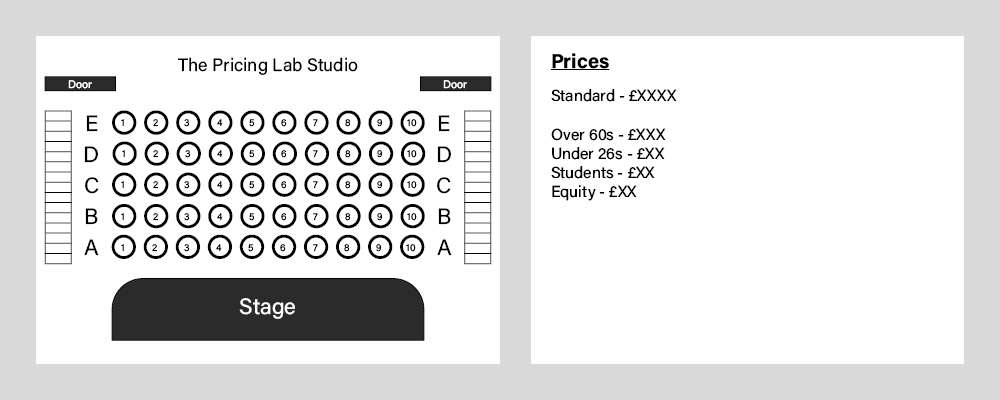
#4 – Bandy Bandy Bandy
So you decide to add in some price bands – it’s a simple way to offer a range of prices and also differentiate between different seats. Now, of course, the quality of any given seat in relation to a performance is completely subjective – so long as it’s not behind a pillar, on fire or for a Shakespeare tragedy – people can assign value to any given seat in a myriad of ways. However, you (yes you) can define the seat’s value through a price plan.
In this version I’ve made the ‘best‘ seats at the front the most expensive, then back to the ‘worst’ on the back row. It offers a few options for people booking in terms of price – I’ve made the concessions proportional to the standard price too. The issue with this plan is that the front row edges (A1-3 & A8 – 10) aren’t as good (they’re off centre) so sell late, and the theatre will tend to book in a strip in the middle with the ends of rows further back and the back row more full. Unless it’s a hard sell in which case the back row will be busy with those customers looking over rows of empty seats.
Rating: 3/10
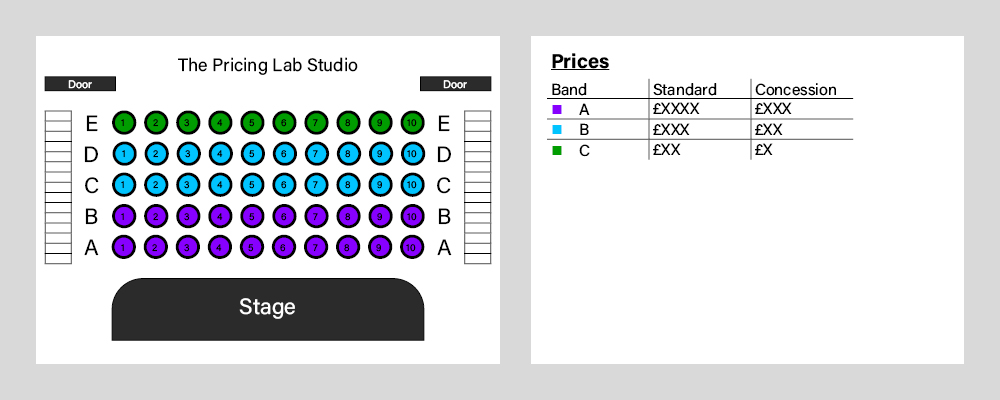
#5 – Tweak my bandy
So I want a busier front row at the sides so I put some band B seats on the front, hoping this makes the financial decision to sit on the front row more palatable. A full front row is nicer for the performers and, after all, it’s subsidised art so that’s who we’re doing this for, right? (calm down, I’m joking) I’ve also moved the top price seats so that I’m maximising income from the centre of the auditorium where people are all booking. It makes a bit of a difference but again I’m a subsidised venue – my art is challenging and boundary pushing, feeding the greatness of the UK arts & theatre economy – so not everything sells out. My back row is still full, as is the centre first 3 rows and front, but those people at the back are still staring over at empty seats.
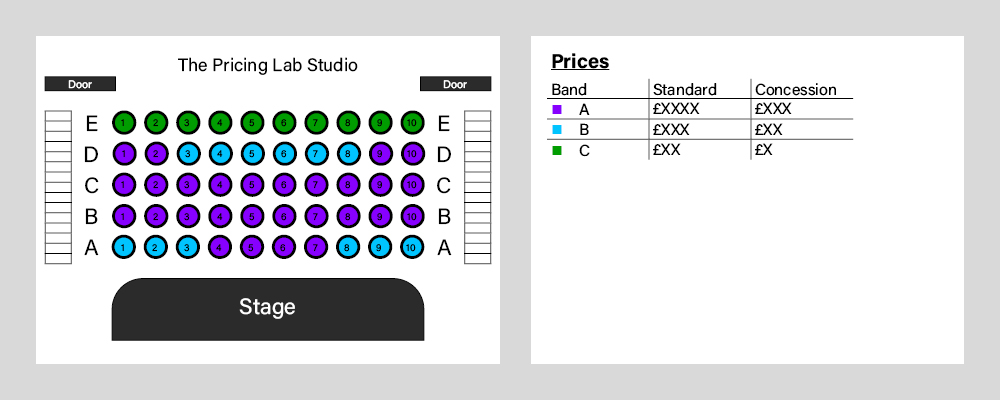
#6 – Reverse Bandy Band Band
We want to really motivate people fiscally to book early, and also to sit at the front (for the performers) – we want to make the show book faster so that we get word-of-mouth earlier, but also so that audiences aren’t peering over swathes of empty seats thinking “this is such a failure of a show” or “I hope he’s not travelled far to perform this” or “it’s a good story but his eyes have a slight sullen sadness”. I’ve put the cheap seats on the front row, getting gradually more expensive as we work our way backwards.
So now we find our theatre is filling a lot nicer than it has before – from the front and middle. Ticket yield is down a little (but that’s where I’m spending a little of my subsidy for my commercially ruinous studio). A few people have found it “ridiculous” that the less good seats at the back are more expensive – hopefully they’ll book earlier next time. For sell-out shows my income is basically the same, for quieter shows I’m hoping to sell more tickets fuelling demand a little and also some word-of-mouth. Bigger audiences is my aim.
However, the last minute seats are now the most expensive ones, accessibility isn’t great (it’s not to worst but this essentially drives early booking from those who can afford to book early: afford both financially and in terms of time – so while it is better overall, it’s not perfect and needs to be accompanied by some other clever schemes)… also I’ve noticed that I’m still getting a strip down the middle of sold seats…
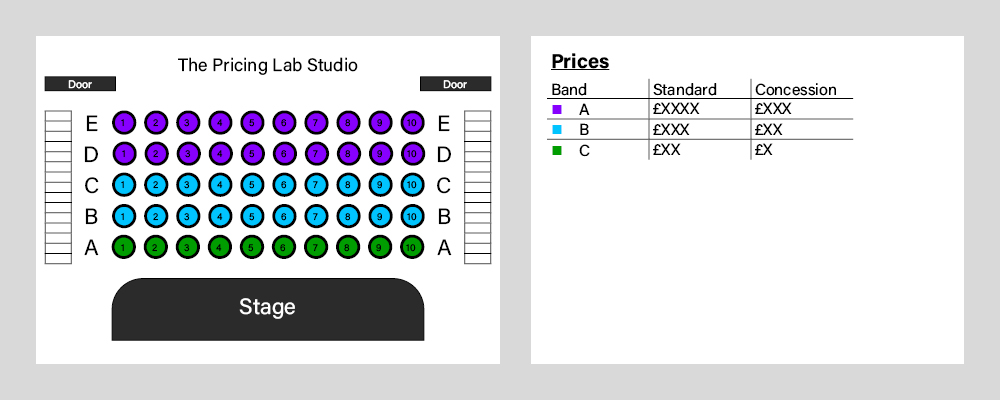
#7 – Tweak My Reverse Band
I’ve done a few tweaks. I’m addicted to this shit by now. Every morning I grab a large strong coffee and stare at the seating plan like a psychopath. I’ve not eaten for 2 days such has been the nutritional value of my obsessive price plan behaviour.
I’ve adjusted my top price band areas to balance out “filling from the front” with “bringing in some sweet cash so the organisation doesn’t fold like Tottenham Hotspur” – I’m trying to make sure that there are price options for as long as possible from on sale to event for audiences, while still emphasising early booking.
End of rows are a mixed bag – sometimes they’re first to go, other times last – in my studio theatre I can’t get anyone to sit in them (because the art I produce is totally ruined by viewing it for even a slight off-centre angle and my culturally-aware audience who love me know this) – so I’ve nudged down the price a little for the edges.
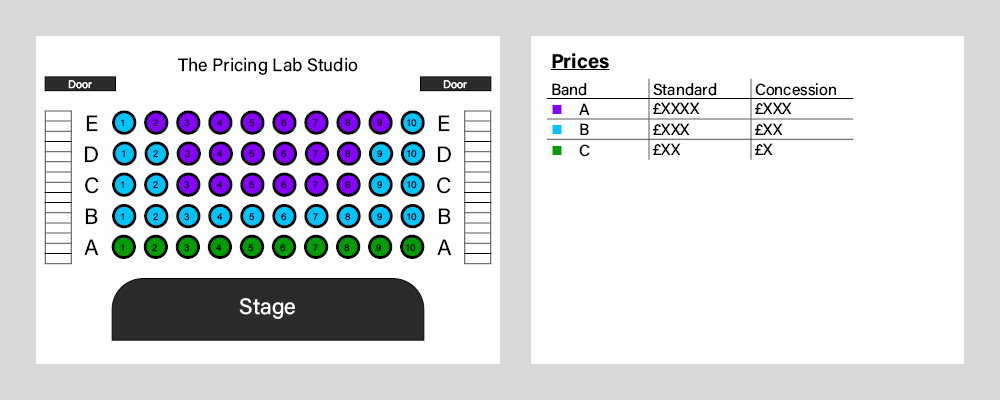
#8 – Dynamically Speaking
Everyone’s been talking about dynamic pricing at Marketing Manager Fight Club. It’s been the talk of the ring, in between the cage fights, the knuckle dusters and the sass. As I walked home, bloodied and bruised, 2 broken legs and a black eye delivered by a laminator held by a Marketing Assistant from Swansea, I started to think about how we can raise our income. The cheaper seats are really important but, crucially, our grants are being cut again AND it’s possible to say that it’s better to be open than closed for ever.
I’m keeping my cheap seats, that’s really important, but now my prices are “From XX” rather than “£XXXX – £XX” (there’s lots on how you phrase pricing – read Priceless by William Poundstone – but only the first 6 chapters really). It means on really high demand shows I’m making more, and for those shows I know will be a struggle (storytelling theatre being the #1 culprit), I am increasing the lower cost tickets.
My concessions are now proportional, which again, not perfect… so…
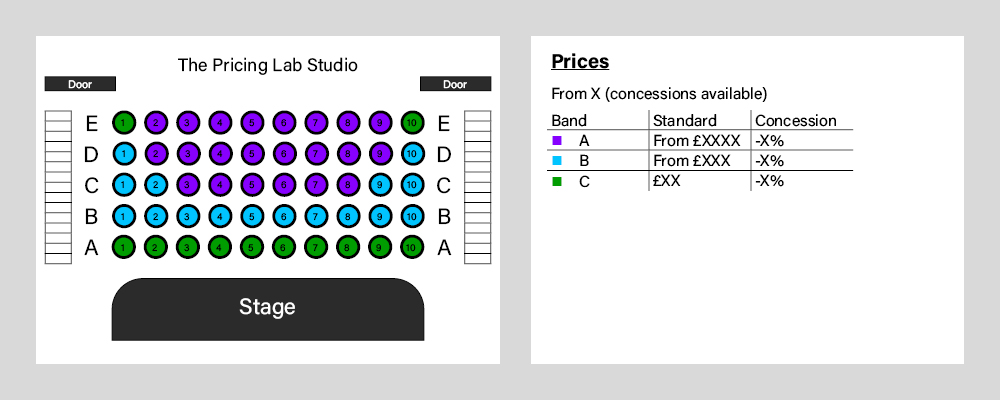
#9 – With Proper Concessions
I’ve bitten the bullet and I’ve decided to make my concessions matter. I don’t want to exclude people who can’t book early from coming to see my show. Also as it happens the studio is doing incredibly well at the moment – the season that included Top Gun: The Musical, The Homecoming Returns and my much-loved one-man version of Titanic has really swelled the books – although I didn’t win an Olivier or a WhatsOnStage award, so, frankly, f**k the industry.
Anyway… I’ve decided that I need a focus on youth (so I’ve got an audience for the future), those with reduced income (to help properly) and Equity members (so I can feed my ego and win the approval of my peers). This suddenly feels better and I feel less inherently evil. I’ve also popped a couple of cheap seats on the back row which are released on the day (I’ve also go some shows in my season where all the tickets are PWYW or super-low cost).
But then I feel there’s more to do…
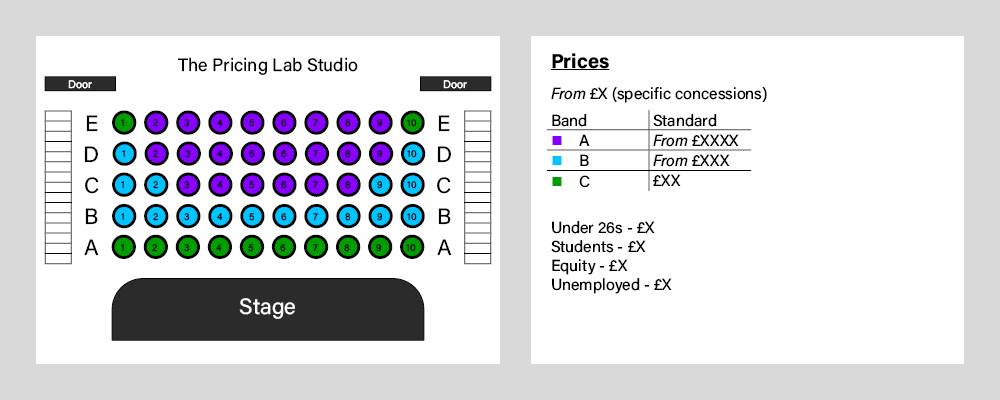
#10 – The Model Citizen
I’m a massive socialist – albeit one that has a keen grasp of reality and who is fairly pragmatic – so, maybe not a massive socialist, maybe an aspirational socialist. The holy grail of theatre ticket pricing is, essentially, means-tested prices – so everyone pays at a level that is appropriate to them and their situation. That is, of course, impossible. But I want to encourage a philanthropic world and ethic in the audience for my studio (which is based in a small town as the only venue for 70 miles).
I’ve introduced Access and Supporter tickets – I’m wanting to encourage people to pay-it-forward if they can – essentially do the opposite of a Tory government – recognising that people who are wealthy are also undoubtedly lucky in a myriad of ways and they can support people who aren’t so much.
I also want to try and help those who fall through the gaps of all my schemes and my concessions a little. I need to find a better name than Access (deffo, any suggestions?), but this feels like a progression…
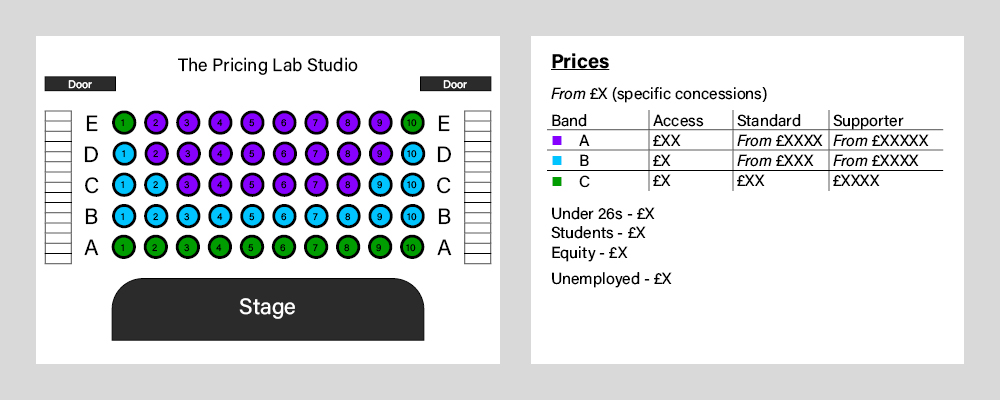
Other ponderings
Then I had a few other ponderings…
- Should all tickets be refundable?
- Why do we never ask audiences what they want to see?
- Why don’t we A/B test artwork before we use it for a campaign?
- Should we be able to recommend a show to someone so they can see it for free (when they book something else), and then give them a QR code link to pay what they think after they’ve seen it?
- Why are the boards of theatres predominantly unrepresentative of society?
- How do regional theatres “break into London” without bankrupting themselves? And should they even want to?
- Should one stage at the NT be devoted to taking shows from the producing regional theatres?
- Should all shows made by producing theatres tour?
- Why did no major artistic name call out Michael Billington on his comments on education and community?
- Should we create producing groups of theatres around the UK to share work?
- Why do we all worry about young people not attending theatre, but also give them no voice on programming groups?
- Why did my complete tour sell less tickets than a comedy night in the theatre I work in?
- Will any theatres e-mail me asking me about the new show?
- Why do theatres always seem to ignore the demographic of their audience and sell bad beer?
And the added extra for pros
Just a picture. Decipher if you can!
Finally… If you enjoy this then tweet me, leave a comment and join my mailing list here!
